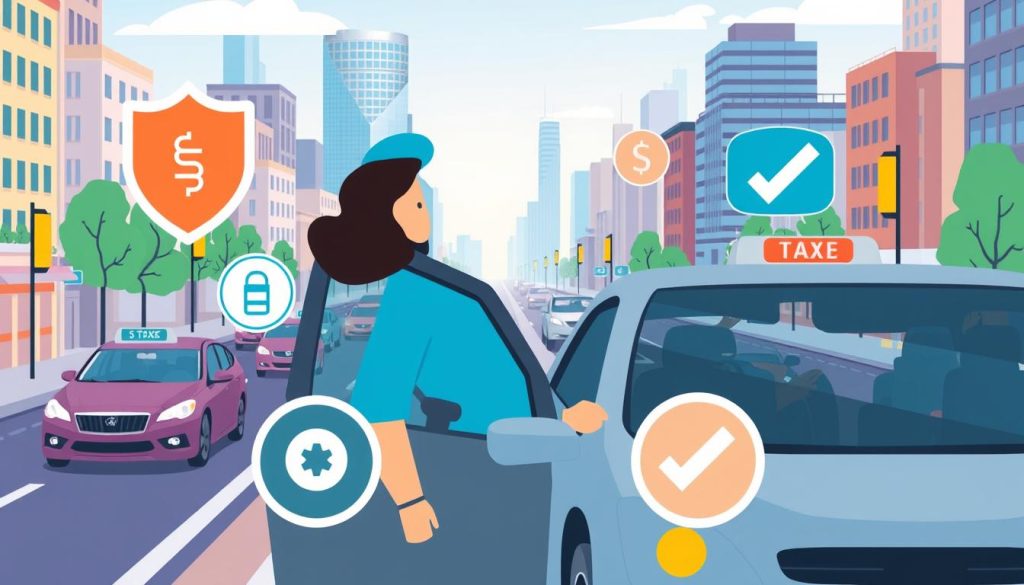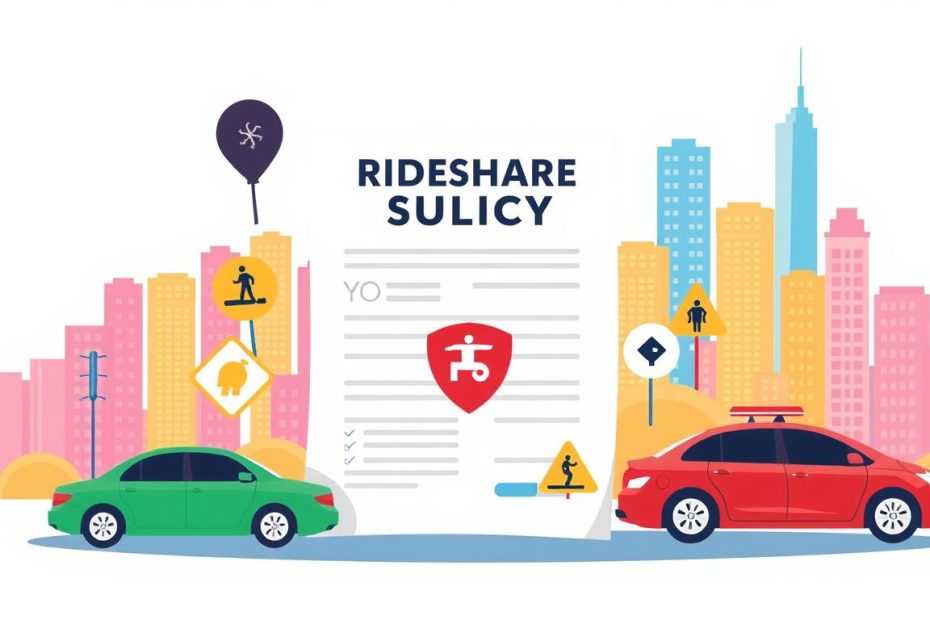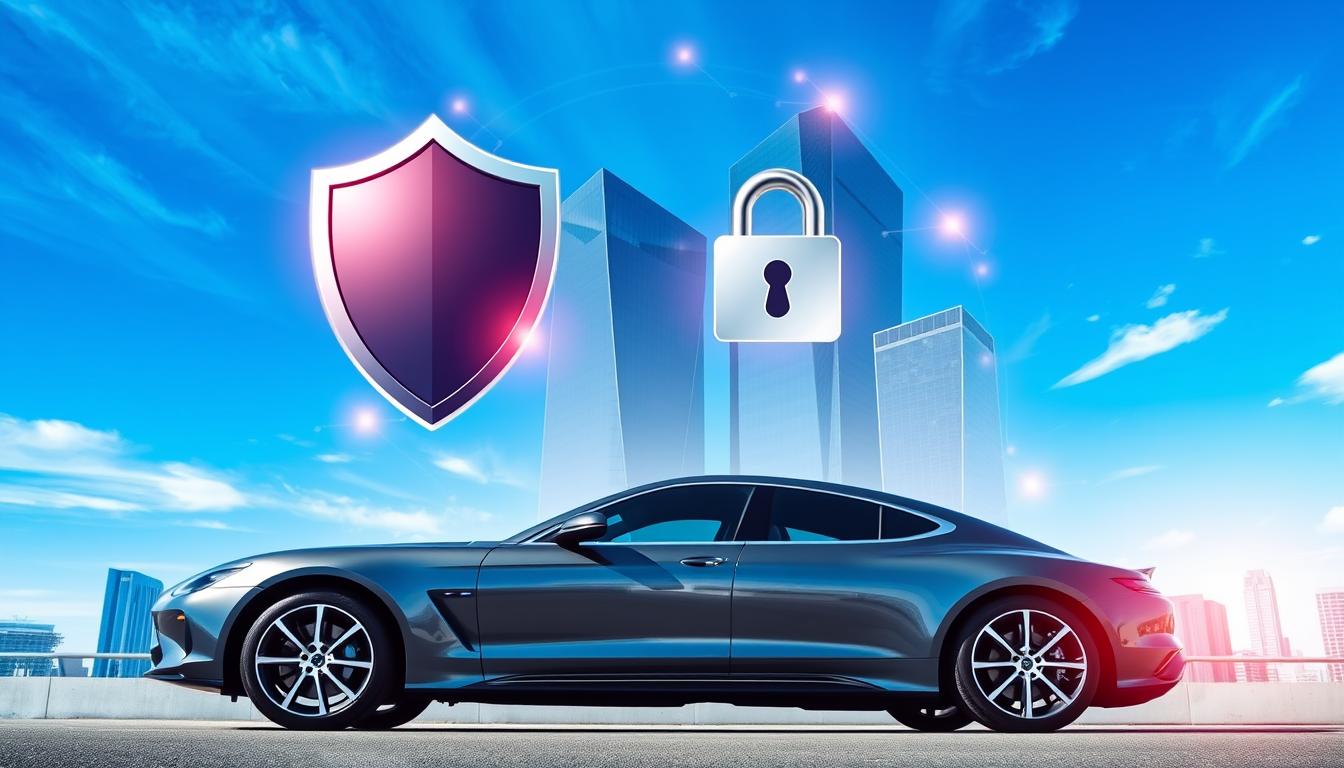In the fast-paced world of Uber and Lyft, the details of rideshare coverage policy can be complex. It’s crucial for drivers to have rideshare driver liability insurance to avoid legal issues and unexpected costs. Some insurers shy away from offering rideshare insurance options, but companies like Progressive provide these as add-ons. Knowing about this insurance is a must in the gig economy today.
Commercial insurance can be more expensive than rideshare-specific options. Progressive offers for-hire insurance in 43 states, showing how coverage varies. Drivers face unique risks, so the insurance industry has created special policies for different driving phases. This includes being offline, waiting for a ride, or actively driving a passenger.
Adding rideshare coverage can raise your usual premium, but not having it can be more costly. Uber provides liability insurance that can cover up to $1,000,000 if the driver causes an accident. But, there are details like Uber’s $2,500 repair deductible and optional protection that drivers need to understand. It’s vital to check your policy and possible additions for full protection.
As rideshare and delivery services grow, insurance must adapt. Uber does not force drivers to buy extra insurance, but having it can prevent vast financial issues. Drivers should carefully review their insurance options. Ensuring clear and honest communication with their insurer is essential to avoid losing coverage.
The Importance of Rideshare Driver Insurance Coverage
Almost two million rideshare drivers work in the United States. Knowing about rideshare driver insurance is very important. This insurance covers areas not handled by personal auto policies or the coverage from ridesharing companies like Uber and Lyft at different times.
Understanding State Requirements for Rideshare Companies
States have their own rules for rideshare companies. This includes rules forrideshare accident coverage. Some states might be okay with a standard auto insurance with a rideshare feature. Yet, others might ask for a commercial insurance when driving for rideshare. Because of this, drivers need the rightrideshare driver insurance. It helps with coverage during the ‘app on but no request received’ phases and similar times.
What Happens if a Rideshare Driver Lacks Proper Coverage?
Not havingthe best insurance for rideshare driverscan cost a lot. For instance, during Period 1, with the app on and no ride called, personal auto policies usually don’t help. If there’s a crash, the driver could pay a lot, or face legal trouble for not having the right insurance. Also, rideshare companies often don’t cover fully during this time. This shows why effective insurance is a must.
Ridesharing comes with big risks and complex rules. Having strong rideshare insurance protects drivers legally and financially. It’s crucial to look carefully and pick the right insurance. This keeps both driver and passengers safe.
Exploring the Layers of Rideshare Insurance Policies
Rideshare insurance is crucial for drivers on platforms like Uber and Lyft. It offers protection at different stages of a job with rideshare driver auto insurance. Knowing about these stages helps drivers choose the best protection against risks.
The basic protection includes rideshare driver vehicle protection similar to personal car insurance. It covers accidents when the app is off. But once the app is on and the driver awaits a ride, personal insurance might not cover everything. Here, specific rideshare insurance steps in to fill the gap during what’s called Period 1.
From the moment a ride is accepted (Period 2) to when the passenger leaves (Period 3), top-level coverage is provided. Rideshare companies usually offer up to $1 million in liability protection. This extensive coverage also often comes with uninsured motorist protection and collision insurance. This comprehensive approach underlines why rideshare insurance is vital, offering good deductibles and broad coverage.
Even though rideshare platforms cover some aspects, there are coverage gaps when waiting for rides. Continuous updates to rideshare driver auto insurance protect drivers legally and financially. It brings peace of mind on every trip, essential in the gig economy.
Navigating the Different Phases of Rideshare Coverage
Understanding rideshare coverage policy phases is key for drivers, whether new or experienced. Shifting from personal use to professional service can leave coverage gaps. This makes choosing the right rideshare driver liability insurance very important.
When not driving for hire, only personal auto insurance applies. But it often doesn’t cover ridesharing. That’s why getting a rideshare coverage policy is wise. It fills the gap when the rideshare app is off. Many insurers offer plans for this specific need.
Offline Period: When Personal Auto Policies Apply
Offline, a driver’s main protection is their personal insurance. Drivers should make sure it includes rideshare activities. Otherwise, they could face big bills if something goes wrong.
Waiting for a Request: Understanding the Risks and Protections
In Phase 1, with the app on but no ride booked, companies like Uber and Lyft offer some insurance. Yet, it might not cover everything. That’s why having extra rideshare driver liability insurance matters.
En Route and On-Trip Coverage Provided by Rideshare Companies
Once a driver accepts a trip, coverage gets better. Uber and Lyft increase their insurance to include more liability protection. With passengers on board, the coverage even helps with big claims, ensuring drivers are well-protected.
Choosing the right insurance for rideshare driving takes careful thought. Drivers should look closely at their needs for each phase of the job. This helps them stay covered and avoid problems later on.
How to Choose the Best Insurance for Rideshare Drivers
Finding the best insurance for rideshare drivers means looking closely at several important factors. Since rideshare driving is unique, it’s important to pick a policy that gives full rideshare accident coverage.
Evaluating Rideshare Driver Vehicle Protection Options
Choosing the right vehicle protection involves considering continuity of coverage. Your insurance should fill the gap between personal auto policies and the coverage needed for rideshare. Companies like State Farm, GEICO, and Progressive provide policies that meet both normal auto insurance needs and rideshare requirements.
Liability Limits and Deductibles: What to Look For
It’s crucial to understand liability limits and choose deductibles wisely when picking rideshare insurance. Opting for higher liability limits might cost more, but they offer better coverage against claims. Selecting a deductible that you can afford ensures protection without financial strain. Finding the right balance between cost and coverage means drivers are well-protected without breaking the bank.
In places like Illinois, looking for affordable options can lead to savings. Auto-Owners, with an average monthly quote of $68, is a good example. Yet, remember the cheapest option may not always be the best insurance for rideshare drivers. The details of the coverage and the quality of customer service matter a lot too.
Choosing the best rideshare insurance involves carefully reviewing coverage choices, understanding liability, and assessing deductibles and premiums. It’s about matching policies to your personal situation and the specific rules of your state.
Rideshare Driver Insurance Coverage for Different Scenarios
Getting to know rideshare driver insurance coverage is key if you drive for a ridesharing company. You will need certain insurance types for different situations. This makes sure everyone involved is safe. We will explore coverage across various situations, including accidents and Uber Eats deliveries.
What Does Insurance Cover in the Event of an At-Fault Accident?
If a rideshare driver causes an accident, insurance details depend on the ride’s phase. In Stage 1, when the driver is just logged in, rideshare driver auto insurance by companies like American Family Insurance kicks in. This stage offers liability coverage. Yet, it might be limited. Once a ride request is accepted, the insurance coverage gets much better.
Companies like American Family Insurance create policies to plug the gaps that Uber’s insurance might leave. They offer collision coverage and cover medical bills if there’s an accident. This way, rideshare drivers are less worried about money issues after an accident. This shows why good rideshare driver insurance coverage matters.
Does Coverage Apply to Rideshare and Delivery Services Like Uber Eats?
Insurance gets a bit tricky for drivers who also deliver with Uber Eats. When making deliveries, rideshare company’s insurance might not fully cover or may not cover at all. It’s crucial to have a solid rideshare insurance that also covers deliveries. Certain insurance policies recognize these situations, making sure drivers are protected, no matter the service they’re providing.
This protection depends on the insurance company and their deals with rideshare and delivery firms. As more drivers do both passenger transport and deliveries, wide-ranging coverage becomes vital.
To wrap it up, having insurance for all your rideshare activities protects you from surprising money troubles. Going with a respected insurance provider like American Family Insurance means you’re getting policies crafted for today’s rideshare needs. It offers both safety and financial stability.
Determining the Cost of Rideshare Driver Auto Insurance
The rideshare driver insurance cost depends on a few things. These include the type of vehicle, driving history, and what coverage you choose. It’s important for drivers to know this. Having this knowledge helps when deciding between personal and commercial insurance.

On average, rideshare drivers might pay $34 more a month for rideshare insurance. This means their total monthly insurance cost could be about $179. This calculation includes typical personal auto insurance costs. So, adding rideshare insurance might only increase yearly costs by $400.
Some companies, like State Farm and USAA, offer cheaper rideshare insurance. Their costs could add just $23 more a month to standard premiums. This shows that drivers from different financial situations can afford rideshare insurance.
Also, the rideshare driver insurance cost can be reduced by choosing the right coverage. This depends on how often you drive for rideshare services. By selecting coverage that fits your driving habits, you can save money. You still get good coverage when driving or waiting for passengers.
In conclusion, there are affordable insurance options for rideshare drivers. These options don’t sacrifice coverage for cost. By looking at different insurance plans, drivers can find something that fits their budget and meets their needs.
The Role of Personal Auto Policies in Rideshare Accident Coverage
Rideshare drivers in the U.S. need to know how personal and rideshare insurance work together. A personal auto policy helps first but has limits when driving for Uber or Lyft. Knowing about insurance layers is key for drivers. In California, a driver’s personal policy covers them only when they’re not using the rideshare app. This leaves gaps that could lead to money problems after an accident on duty.
Understanding Personal Auto Policy Limitations
Rideshare insurance and personal policies are not the same. Personal policies often don’t cover business driving, like ridesharing. For example, in California’s Period 1, with no passenger yet, Uber and Lyft offer basic insurance. But drivers must have their own insurance too. This insurance is crucial while waiting for rides. California rules require extra coverage from TNCs (Transportation Network Companies). This shows the value of having a personal policy that includes TNC use.
Maintaining Continuous Coverage: Rideshare vs. Personal Use
Drivers need insurance that covers both personal and rideshare driving. This is vital in California, where many drive without insurance. Gap coverage or rideshare endorsements help during times with less coverage. During active rides, Uber and Lyft provide much larger coverages. This includes $1 million for liability and UM/UIM coverages. This large coverage means more safety but could also mean higher premiums. Basically, having a solid rideshare coverage plan is essential for financial security in the uncertain world of ridesharing.


